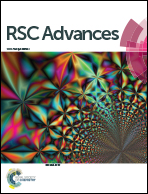DNA templated self-assembly of gold nanoparticle clusters in the colorimetric detection of plant viral DNA using a gold nanoparticle conjugated bifunctional oligonucleotide probe
Abstract
The DNA templated self-assembly of gold nanoparticles clustered in different configurations (n = 2–∞) was investigated in the colorimetric detection of ToLCNDV DNA using a gold nanoparticle conjugated bifunctional oligonucleotide probe. The AuNP-bifunctional oligonucleotide probe conjugate was prepared using citrate capped AuNPs (∼19 nm) and virus specific ssoligo probes 1 and 2. Each conjugate consisted of ∼105 ssoligo probes 1 and 2, specific for the forward and reverse strands of the PCR amplified ToLCNDV dsDNA target. The intensity of the UV-visible absorbance spectra of AuNP-bifunctional oligonucleotide probes decreased gradually after hybridization with increasing ratios of dsDNA targets (0.0–1.0). Hybridized AuNP-bifunctional oligonucleotide probes showed gradual resistance against salt induced aggregation with increasing concentrations of dsDNA target, up to the ratio of 1.0. The color of solution remained red even after hybridization of the AuNP-bifunctional oligonucleotide probe with the dsDNA target. These hybridized AuNP-bifunctional oligonucleotide probes were found as clusters with different configurations (n = 2–11) and defined interparticle distances (1.3–2.1 nm). This target DNA guided the self-assembly of the AuNP-bifunctional oligonucleotide probes which is the reason for the different optical absorbance properties of hybridized solutions before and after the salt treatment. An exciting finding of this investigation is that the AuNP-bifunctional oligonucleotide probes were anchored on the center core particle, tending to form a AuNP cluster that incorporated from 1–6 Au-NP probes and extended to 8 and 10 with an increasing size of core particle diameter. The assembly of three dimensional DNA templated AuNP clusters in flower and pyramid shapes was possible with a dsDNA target and a AuNP-bifunctional oligonucleotide probe but not with a AuNP-monofunctional oligonucleotide probe. The limit of detection of dsDNA target in this bifunctional nanoprobe assay was ∼7.2 ng. Also, this AuNP-bifunctional oligonucleotide probe could reduce the concentration of target DNA required for colorimetric detection by half, as it could recognise both strands in the dsDNA target simultaneously. The proof of this concept will be used for further development of ultra sensitive nanoassay methods and will also be applicable for materials science applications.


 Please wait while we load your content...
Please wait while we load your content...